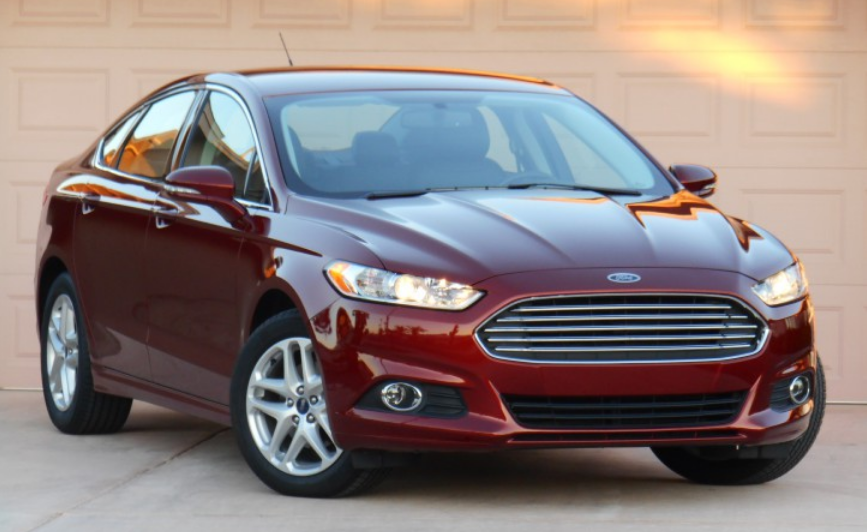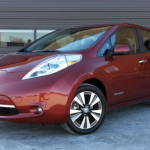
Class: Midsize Car
Miles Driven: 260
Fuel Used: 10.3 gallons
Real-world fuel economy: 25.1 mpg
Driving mix: 30% city, 70% highway
EPA-estimated fuel economy: 25/37/29 (city/highway/combined)
Base price: $23,935 (not including $825 destination charge)
Options on test car: SE Luxury Package ($2350), Reverse sensing system ($295), Start-stop ($295), rear inflatable seatbelts ($190)
Price as tested: $27,890
Quick Hits
The great: Clear, easy-to-use control layout, front-seat room/comfort
The good: Acceleration/economy balance, interior storage and materials
The not so good: Transmission hesitates to kick down for passing
More Fusion price and availability information
Rick Cotta
Ford’s Fusion plays in the hugely popular midsize-sedan sandbox dominated by the Toyota Camry and Honda Accord. Yet the Fusion holds its own, consistently being among the top-five sellers in what remains the nation’s highest-volume segment.
And well it should be. Our tester was the step-up SE model (the base being the S) with five options that added $3130 to the starting price of $23,935, bringing the total to $27,890 including destination. While that’s hardly bargain transportation, our test car included a healthy level of equipment along with pleasing accommodations and acceptable performance.

The last was, frankly, a bit of a surprise. Looking at the window sticker, one of the first things I noticed was that our SE was powered by a tiny, 1.5-liter 4-cylinder engine, albeit with turbocharging and other tricks that earned it Ford’s famed “EcoBoost” badge—and a stout 181-horsepower rating. In combination with the standard 6-speed automatic transmission and optional automatic start/stop system (which shuts the engine off at stops and then restarts it when your foot moves off the brake pedal), it also earned EPA ratings of 25 city/37 highway, quite impressive for a midsize sedan.
In our test, however, it wasn’t quite that impressive. We averaged 25.1 mpg over 260 miles of about 70% highway driving, though some of that was admittedly in hilly terrain that doesn’t do anything for fuel economy. Also, the start/stop system worked fairly smoothly and unobtrusively, though a quick move from the brake to the gas pedal could “beat” the restart a bit; start/stop can be disabled with a simple console button if you choose. This system was a $295 option on our test car, and one that probably isn’t worth it for most drivers. It’s unlikely to save $295 worth of gas over any reasonable time period, and it would probably be more expensive than usual to replace the (often used) heavy-duty starter motor if it goes out. For those really interested in fuel economy, Fusion also comes in Hybrid and Plug-In Hybrid versions, but they’re significantly more expensive, and they provide most of their fuel-economy benefit in city driving.
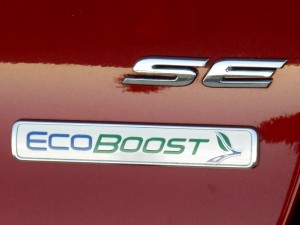
Many turbocharged engines—particularly small ones—suffer pronounced “turbo lag”; a delay in acceleration after stabbing the throttle, especially from a stop. While that was evident in the Fusion, it was uncommonly brief. Given the spurs when the light turned green, the Fusion moved away with a decent jump, and 15 feet out, enough power came in to chirp the front tires. There was a similar delay when hitting the throttle at speed, though that was due to the transmission’s reluctance to kick down quickly to a lower gear. But overall, the Fusion came off as being adequately quick, at least when lightly loaded. Note that the standard engine is a non-turbo, 175-horsepower 2.5-liter 4-cylinder, with 1.6-liter and 2.0-liter turbo 4-cylinders (the latter with a rousing 240 horsepower) also available. It’s also worth noting that while our test car was front-wheel drive, an all-wheel drive version is offered—somewhat of a rarity in the midsize class.
As befits a family sedan, the Fusion SE rides quite smoothly and handles competently; no complaints—or surprises—there.
Similarly, there’s the expected amount of midsize room inside. However, it’s worth noting that the front seats go back farther than might be expected, providing ample leg room even for tall folks, and an average adult can still squeeze into the back seat behind them. Our tester also had a power-tilt driver-seat cushion with power lumbar adjustment for the backrest, both nice comfort features. Side bolsters on the front seat cushions are quite high, however, which may impede egress for some people.
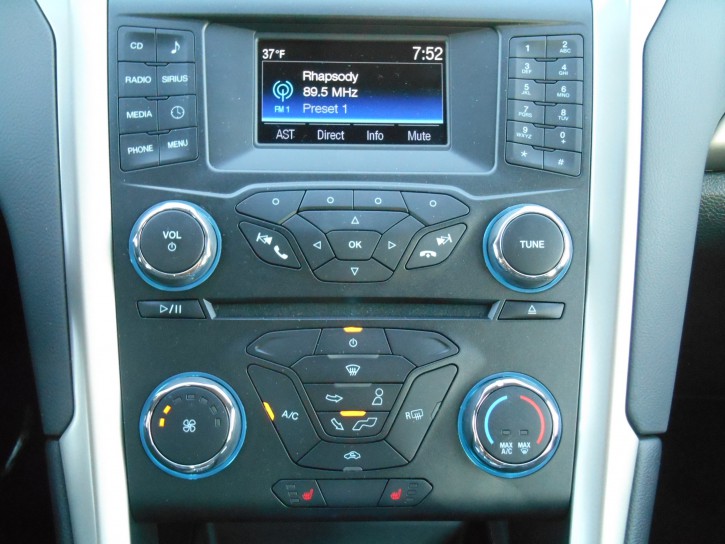
Visibility is a mixed bag. While the front and rear roof pillars are unusually thin and block little of your vision, our tester didn’t come with a rearview camera—odd at this price point—though it did have optional (at $295) rear-obstacle detection. Also, the side pillars are wide enough to hinder the over-the-shoulder view, though wide-angle lenses built into the outside rearview mirrors help a bit … but they’d help a bit more if they were larger.
Audio and climate controls are unusually simple to use—at least for this day and age—consisting largely of gen-u-ine buttons and knobs. They’re mostly easy to reach, though the station-select buttons are positioned a bit too far to the right for easy access. Also impressive is that all buttons, from the overhead lights to those on the door armrest and steering wheel, are well illuminated at night. Altogether, big points to the Fusion in the “Controls” category.
Interior storage space also earns kudos. There’s a decent-sized 2-tier glovebox, a deep console box with Aux/USB/12-volt jacks, a small console tray, 2 cupholders, a large forward console bin with 12-volt plug and side access, and map pockets in the doors.

Our test car’s monotone black color scheme made the interior look a bit somber, despite slashes of dark woodgrain trim with grey, silver, and chrome accents. However, material quality was a cut above the class norm, as virtually all “touch points”—including the dash top, door tops, and armrests—were nicely padded.
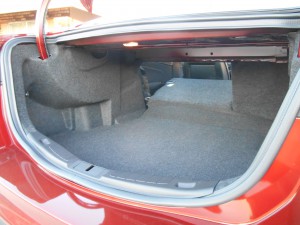
The good-size trunk has a wide channel in back, the only downside being that the sickle-shaped trunk-lid hinges dip deeply into the luggage area, though they’re covered to prevent damage. Rear seat backs fold level with the trunk floor and nearly flat, so loading long, bulky items is easy—as long as they fit through the rather restricted pass-through opening.
While it’s hard to say that the Fusion really excels in many areas when compared to its numerous, excellent rivals, one of its strengths is that it has so very few weaknesses. It’s also one of only three domestic nameplates in the segment (the others being the Chevrolet Malibu and Chrysler 200), which for some may help narrow the field. Also, many have commented that it’s one of the best-looking cars in the class, and those struck by its style will likely not be disappointed with its substance.

